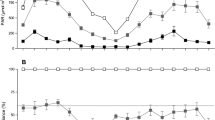Abstract
Photosynthetic and growth characteristics of Mosla chinensis and M. scabra were compared at three irradiances similar to shaded forest understory, forest edge, and open land. At 25 % full ambient irradiance, M. chinensis and M. scabra had similar photosynthetic characteristics, but saturation irradiance, compensation irradiance, and apparent quantum yield of M. chinensis were higher than those of M. scabra at full ambient irradiance and 70 % full ambient irradiance. At the same irradiance treatment, specific leaf area and leaf area ratio of M. chinensis were lower than those of M. scabra. Photon-saturated photosynthetic rate and water use efficiency of M. chinensis, however, were not significantly higher than those of M. scabra, and the leaf area and total biomass were lower than those of M. scabra. As a sun-acclimated plant, the not enough high photosynthetic capacity and lower biomass accumulation may cause that M. chinensis has weak capability to extend its population and hence be concomitant in the community.
Similar content being viewed by others
Abbreviations
- AQY:
-
apparent quantum yield
- B:
-
total biomass
- CI:
-
compensation irradiance
- E:
-
transpiration rate
- HI:
-
high irradiance
- LA:
-
leaf area
- LAR:
-
leaf area ratio
- LI:
-
low irradiance
- LMR:
-
leaf mass ratio
- MI:
-
medium irradiance
- P max :
-
photon-saturated photosynthetic rate
- P N :
-
net photosynthetic rate
- PPFD:
-
photosynthetic photon flux density
- SI:
-
saturation irradiance
- SLA:
-
specific leaf area
- WUE:
-
water use efficiency
References
Anderson, J.M.: Photoregulation of the composition, function and structure of thylakoid membranes. — Annu. Rev. Plant Physiol. 37: 93–136, 1986.
Chazdon, R.L., Pearcy, R.W., Lee, D.W., Fetcher, N.: Photosynthetic responses of tropical forest plants to contrasting light environments. — In: Mulkey, S.S., Chazdon, R.L. Smith, A.P. (ed.): Tropical Forest Plant Ecophysiology. Pp. 5–55. Chapman and Hall, New York 1996.
Fang, Y.Y., Wang, J.X., Wei, Z.: Flora of Zhejiang. — Pp. 289–290. Science and Technology Publishing House, Zhejiang 1989.
Guan, B.H., Ge, Y., Chang, J.: Phenotypic plasticity of Mosla chinensis and M. scabra (Labiatae) response to soil water status. — Bot. Bull. Acad. sin. 45: 229–236, 2004.
Guan, B.H., Ge, Y., Fan, M.Y., Niu, X.Y., Lu, Y.J., Chang, J.: Phenotypic plasticity of growth and morphology in Mosla chinensis responds to diverse relative soil water content. — Acta ecol. sin. 23: 259–263, 2003.
Hunt, R.: Plant Growth Analysis. — Edward Arnold, London 1978.
Jeangros, B., Nösberger, J.: Comparison of the growth response of Rumex obtusifolius L. and Lolium perenne L. to photon flux density. — Weed Res. 32: 311–316, 1992.
Kremer, E., Kropff, M.J.: Comparative growth of triazine-susceptible and-resistant biotypes of Solanum nigrum at different light levels. — Ann. Bot. 83: 637–644, 1999.
Lortie, C.J., Aarssen, L.W.: The specialization hypothesis for phenotypic plasticity in plants. — Int. J. Plant Sci. 157: 484–487, 1996.
Mulkey, S.S., Pearcy, R.W.: Interactions between acclimation and photoinhibition of photosynthesis of a tropical forest understory herb, Alocasia macrorrhiza, during simulated canopy gap formation. — Funct. Ecol. 6: 719–729, 1992.
Semb, K.: Growth characteristics of spring barley and selected weeds. I. Effect of irradiance in growth chambers. — Weed Res. 36: 339–352, 1996.
Stitt, M., Schulze, D.: Does Rubisco control the rate of photosynthesis and plant growth? An exercise in molecular ecophysiology. — Plant Cell Environ. 17: 465–487, 1994.
Valladares, F., Wright, S.J., Lasso, E., Kitajima, K., Pearcy, R.W.: Plastic phenotypic response to light of 16 congeneric shrubs from a Panamanian rainforest. — Ecology 81: 1925–1936, 2000.
Vats, S.K., Pandey, S., Nagar, P.K.: Photosynthetic response to irradiance in Valeriana jatamansi Jones, a threatened understorey medicinal herb of werstern Himalaya. — Photosynthetica 40: 625–628, 2002.
Xu, D.Q., Shen, Y.G.: The limit factor of photosynthesis. — In: Yu, S.W. (ed.): Plant Physiology and Molecular Biology. 2nd Ed. Pp. 223–236. Science Press, Beijing 1998.
Zhang, S., Ma, K., Chen, L.: Response of photosynthetic plasticity of Paeonia suffruticosa to changed light environments. — Environ. exp. Bot. 49: 121–133, 2003.
Zhang, S.A., Xu, B.S.: A study on the variation patterns of Mosla in the Yangtze delta on population level. — Acta bot. yunnan. 10: 409–421, 1988.
Zhou, S.: Genetic divergence and analysis of the relationships between species of Mosla (Labiatae). — Acta phytotaxon. sin. 37: 10–19, 1999.
Author information
Authors and Affiliations
Corresponding author
Rights and permissions
About this article
Cite this article
Liao, JX., Ge, Y., Huang, CC. et al. Effects of irradiance on photosynthetic characteristics and growth of Mosla chinensis and M. scabra . Photosynthetica 43, 111–115 (2005). https://doi.org/10.1007/s11099-005-1115-6
Received:
Accepted:
Issue Date:
DOI: https://doi.org/10.1007/s11099-005-1115-6



